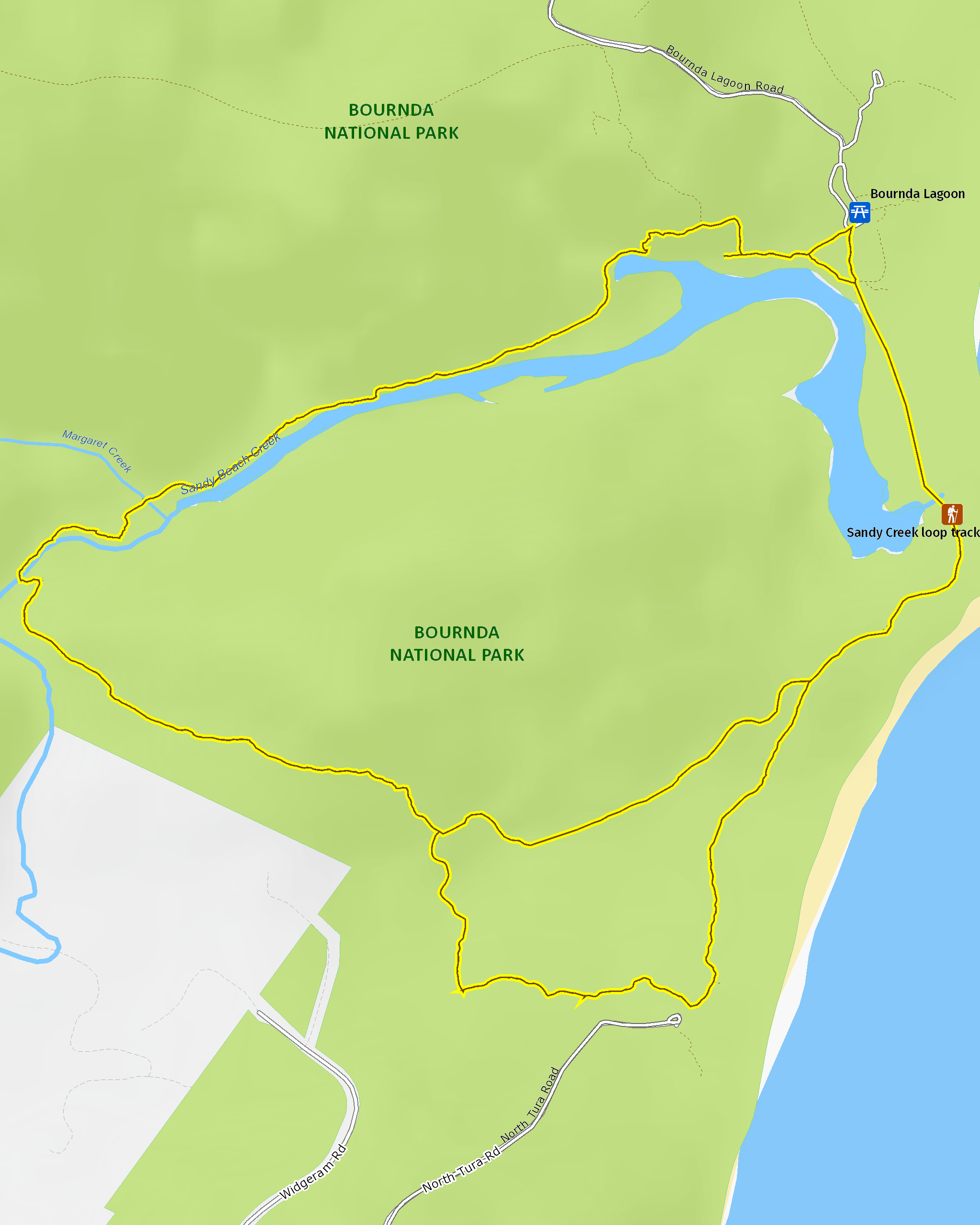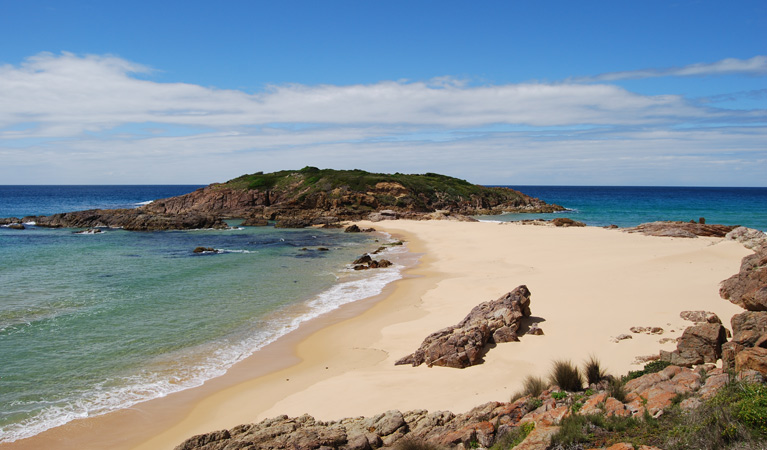Overview
Taking in Bournda Lagoon, Sandy Creek and pockets of dry sclerophyll forest, Sandy Creek loop track is a hike in Bournda National Park on the far South Coast.
- Where
- Bournda National Park in South Coast
- Distance
- 6km loop
- Time suggested
- 2 - 3hrs
- Grade
- Grade 4
- Entry fees
- Park entry fees apply
- What to
bring - Hat, sunscreen, drinking water
Sandy Creek loop track is a moderately challenging hiking trail that will keep you interested all the way round. The track passes through various natural habitats, such as dry sclerophyll forests, she-oak thickets, pockets of rainforest and an avenue of paper barks that fringe the picturesque Bournda Lagoon. The loop takes in the coastline, Sandy Beach Creek and Bournda Lake so bring along your swimmers and fishing rod.
Birdwatching is a great thing to do in Bournda, and you’ll be able to see and hear a range of birds while you’re walking this track. Keep an eye out for raucous glossy-black and yellow-tailed black cockatoos, and the graceful sea eagles can often be seen hunting along the coastline.
Remember to also look down occasionally to see if you can spot any delicate rock orchids. In spring the air is sweetened by the orchid’s perfume and by other native wildflowers such as those of the giant honey myrtle. Keep an eye out for swamp wallabies, kangaroos and water dragons.
Map

Map legend

Local alerts
For the latest updates on fires, closures and other alerts in this area, see https://www.nationalparks.nsw.gov.au/things-to-do/walking-tracks/sandy-creek-loop-track/local-alerts
General enquiries
- National Parks Contact Centre
- 7am to 7pm daily
- 1300 072 757 (13000 PARKS) for the cost of a local call within Australia excluding mobiles
- parks.info@environment.nsw.gov.au
Park info
- in Bournda National Park in the South Coast region
Bournda National Park is always open but may have to close at times due to extreme weather or fire danger.
-
Park entry fees:
$8 per vehicle per day. This park uses a self-registration fee collection system, please bring correct change.
Buy annual pass.
Visitor info
All the practical information you need to know about Sandy Creek loop track.
Track grading
Features of this track
Distance
6km loop
Time
2 - 3hrs
Quality of markings
Sign posted
Experience required
Some bushwalking experience recommended
Gradient
Gentle hills
Steps
Occasional steps
Quality of path
Rough track, many obstacles
Getting there and parking
Sandy Creek loop track is in the southern section of Bournda National Park.
To get there from the south:
- Travel along Sapphire Coast Drive for approximately 6km
- Take the Widgeram Road/North Tura turnoff and follow this road
- Turn right at the T intersection into the carpark for the North Tura viewing platform and join the track from there
To get there from the north:
- Travel along Sapphire Coast Drive to the Bournda Road/Hobart Beach campground turnoff
- Follow this road for approximately 3km then take the right turn to Bournda Lagoon
- After about 2.5km you will arrive at the Bournda Lagoon carpark from where the track begins
Parking
Parking is available nearby Sandy Creek loop track. Please note that a park use fee applies.
Best times to visit
There are lots of great things waiting for you in Bournda National Park. Here are some of the highlights.
Autumn
As the weather cools but the waters are still warm, it's a great time to enjoy the Kangarutha walking track. Swim along the way at secluded beaches. It will feel like you have the place to yourself.
Spring
Enjoy the colours of wildflowers and the take in the smells of spring as the park comes alive. Head to the lookout at North Tura, find a sunny spot and look out for whales passing in the distance.
Summer
Discover the water activities on offer. Paddling at Bournda Lagoon, sailing on Wallagoot Lake, fishing at Wine Glass Bay or surfing and swimming at any one of the secluded beaches.
Facilities
- Drinking water is not available in this area so it’s a good idea to bring your own.
- You are encouraged to bring gas or fuel stoves, especially in summer during the fire season.
Maps and downloads
Permitted
Fishing
A current NSW recreational fishing licence is required when fishing in all waters.
Prohibited
Gathering firewood
Pets
Pets and domestic animals (other than certified assistance animals) are not permitted. Find out which regional parks allow dog walking and see the pets in parks policy for more information.
Smoking
NSW national parks are no smoking areas.
Learn more
Sandy Creek loop track is in Bournda National Park. Here are just some of the reasons why this park is special:
Birdwatchers haven

With around 200 species of birds in the area, Bournda is a birdwatcher's paradise. The estuarine wetlands at the eastern end of Wallagoot Lake provide roosting and feeding areas for a large variety of waders and waterfowl. Keep your eyes out for threatened species like the little tern, hooded plover and pied oystercatcher. Bondi Lake is the largest freshwater lake situated behind coastal dunes in the region, and is another important habitat for waterbirds.
- Bournda Environmental Education Centre Bournda Environmental Education Centre offers school environmental education programs for Kindergarten to Year 12 students. It is located in Bournda National Park, near Tathra.
- Bournda Lagoon Bournda Lagoon is an ideal spot within Bournda National Park, near North Tura, where kids can swim, fish and go paddling and picnic among the paper barks.
- Canoe Bournda Lagoon Glide across the calm waters of Bournda Lagoon on a guided canoe tour with a National Parks discovery guide. Find out about this special part of Bournda National Park, near Tathra.
- Kangarutha walking track Kangarutha walking track, in Bournda National Park, is a hiking route with scenic coastal views and birdwatching, picnicking and swimming opportunities along the way.
- Sandy Creek loop track Taking in Bournda Lagoon, Sandy Creek and pockets of dry sclerophyll forest, Sandy Creek loop track is a hike in Bournda National Park on the far South Coast.
Get active

With so much to do, there's no excuse not to get active in Bournda. The beaches and waterways offer a range of options for watersport enthusiasts - waterskiing, boating, paddling, sail boarding, fishing, swimming and surfing. The coastal walk is perfect for hikers and those hoping to spot migrating whales. And for cyclists, the roads throughout the park are an extensive network to navigate on your bike.
- Living Country, living culture Join us for Living Country, Living Culture – a Stage 2 History excursion in Bournda National Park. In this cross-curricular program, an Aboriginal guide will help students understand the importance of culture and caring for Country.
- Living Country, living culture Join us for Living Country, living culture – a Stage 3 Geography excursion in Bournda National Park. In this cross-curricular program, an Aboriginal guide will help students understand the importance of culture and caring for Country.
- Living Country, living culture Join us for Living Country, living culture – a Stage 1 History excursion in Bournda National Park. In this cross-curricular program, an Aboriginal guide will help students understand the importance of culture and caring for Country.
Ships ahoy

There's plenty of fascinating heritage in Bournda, dating back to the 1830s when European settlement of the district began. Today, you can still see anchor bolts at Kangarutha Point, which was established as a port with Kianinny Bay in 1859. It's also believed the existing track to the point, and parts of the coastal walk, were once used to supply ships anchored there, and transport produce and passengers. Some building remains can also be found around Games Bay, which was cleared for dairy farming by settler Mr Games.
The land of generations

Bournda has been a special place for the Dhurga and Yuin people for thousands of years, with its plentiful food supply and quarry for making tools. As you explore the park and its wildlife, it'll be no surprise that 'Bournda' means 'place of tea tree and kangaroos'.
- Bournda Environmental Education Centre Bournda Environmental Education Centre offers school environmental education programs for Kindergarten to Year 12 students. It is located in Bournda National Park, near Tathra.
- Living Country, living culture Join us for Living Country, Living Culture – a Stage 2 History excursion in Bournda National Park. In this cross-curricular program, an Aboriginal guide will help students understand the importance of culture and caring for Country.
- Living Country, living culture Join us for Living Country, living culture – a Stage 3 Geography excursion in Bournda National Park. In this cross-curricular program, an Aboriginal guide will help students understand the importance of culture and caring for Country.
- Living Country, living culture Join us for Living Country, living culture – a Stage 1 History excursion in Bournda National Park. In this cross-curricular program, an Aboriginal guide will help students understand the importance of culture and caring for Country.
- Traditional weaving workshop: Bournda Get creative on a traditional weaving workshop in Bournda National Park, near Bega and Merimbula. Learn Aboriginal weaving techniques and see how these ancient skills carry a strong connection to Aboriginal culture.

